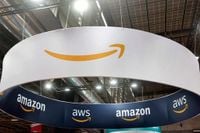Early Monday morning, the world awoke to a digital jolt: Amazon Web Services (AWS), the backbone of much of the internet, suffered a major outage that rippled across continents and industries. From social media apps to banking platforms, millions of users found themselves locked out, unable to access services they depend on daily. This incident, which began in the pre-dawn hours of October 20, 2025, exposed just how deeply AWS is woven into the fabric of modern life—and how vulnerable that reliance can be when things go awry.
The trouble started around 1:26 a.m. ET, when AWS confirmed “significant error rates for requests.” By 3:11 a.m. ET, the company’s status page was reporting increased error rates and latencies for multiple services in its US-EAST-1 region—one of its busiest data hubs. According to Fox Business, the outage was traced to a Domain Name System (DNS) failure, a foundational component of the internet that translates website names into the numerical addresses computers use to find each other. Without DNS, as cybersecurity expert Mike Chapple told Newsweek, “Amazon had the data safely stored, but nobody else could find it for several hours,” likening the event to “temporary amnesia” for the internet.
As the outage spread, the scale of disruption quickly became apparent. Downdetector, a real-time outage tracker, logged more than 6.5 million user-submitted reports across over a dozen countries in the first hours alone. The U.S. led with over 1.4 million reports, followed by the U.K., Netherlands, Australia, France, and Japan. According to BBC and Newsweek, more than 1,000 companies and platforms were affected, including household names like Snapchat, Roblox, Fortnite, Ring, Coinbase, Venmo, Robinhood, Canvas learning platform, Pinterest, Wordle (NYT Games), and even banking apps like Halifax, Lloyds, and Bank of Scotland. For many, the disruption hit during peak usage hours, compounding the frustration and financial risk.
“The underlying DNS issue has been fully mitigated, and most AWS Service operations are succeeding normally now,” AWS reported in a 6:35 a.m. ET update. However, the company cautioned that “some requests may be throttled while we work toward full resolution,” signaling that recovery was still underway. By late morning, AWS acknowledged lingering instability, particularly with its Elastic Compute Cloud (EC2) service, which lets businesses rent virtual servers. To stabilize operations, AWS temporarily limited new EC2 launches and continued to investigate the root cause.
The impact was felt far and wide. In the education sector, thousands of students and teachers were unable to access assignments on the Canvas learning platform, which displayed a damaged rocket animation and a message noting that recovery efforts were ongoing. The outage also disrupted Duolingo, the language-learning app, and Wordle, the popular puzzle game hosted by the New York Times. Users of the Ring doorbell system—owned by Amazon—found themselves unable to access live feeds or security camera footage, while platforms like Pinterest and Chime (a mobile banking app) reported technical errors and service interruptions.
Financial markets were not spared. Robinhood, the trading platform, confirmed that its services were affected by the AWS outage, raising concerns about access and transaction delays for retail investors during peak market hours. Coinbase, a leading cryptocurrency exchange, also attributed its downtime to AWS, according to Reuters. Monica Eaton, founder and CEO of Chargebacks911 and Fi911, warned that “outages like this cause frustrated users, but also trigger a domino effect across payment flows. Failed authorizations, duplicate charges, broken confirmation pages—all of that fuels a wave of disputes that merchants will be cleaning up for weeks.”
As AWS worked to restore services, the incident became a talking point for industry leaders and critics alike. Elon Musk, never one to miss a chance to stir the pot, took to X (formerly Twitter) to mock AWS and promote his platform’s encrypted chat features, boasting that X remained unaffected. Meanwhile, Anthony Anzalone, founder of the blockchain platform XION, called the outage “a wake-up call for businesses to rethink their reliance on centralized cloud infrastructure.” He argued that the growing frequency and cost of outages across major cloud providers like AWS, Azure, and AT&T—disrupting over 500 million users and costing up to $40 billion in the past year—show the need for a shift toward decentralized, blockchain-based solutions. “Despite its distributed appearance, the internet relies on chokepoints that fail under pressure,” Anzalone said, adding, “The shift from Web2 to Web3 isn’t just smart—it’s inevitable for businesses that can’t afford downtime.”
The outage also reignited debates about the fragility of digital supply chains. Sam Harris, Vice President at global consultancy Proxima, told Newsweek that “dependency risk isn’t limited to manufacturing or logistics—it exists deep within digital infrastructure too.” He emphasized that while some businesses with redundant setups avoided significant disruption, others suffered concentrated outages where AWS was their sole provider. “Building genuine redundancy is costly, but essential for sectors where even brief downtime is unacceptable,” Harris added, warning that as demand for AI and cloud services grows, “outages like this could become more common.”
Charlotte Wilson, head of enterprise at Check Point Software, echoed these concerns, stating, “This is another reminder that the digital world doesn’t stop at borders—a local fault can ripple worldwide in minutes. We’ve built convenience on shared systems, but resilience still depends on people and process.” She advised both individuals and organizations to diversify their digital strategies, keep good backups, and stay vigilant against scams that often spike during outages.
The financial toll of the outage remains to be seen. Back in 2017, a four-hour AWS S3 outage cost S&P 500 companies an estimated $150 million. The July 2024 CrowdStrike malfunction, by comparison, resulted in $5.4 billion in losses for Fortune 500 companies and caused chaos in airlines, banks, and hospitals worldwide. While it’s too early for precise figures, the widespread nature of Monday’s AWS incident suggests that the cost could be substantial, especially as businesses grapple with lingering payment disputes and operational headaches.
For many, the outage was a stark reminder of how much of the modern world runs on invisible infrastructure. AWS alone held 37% of the global cloud market share in 2024, generated $107.6 billion in revenue, and operated in 38 geographic regions, supporting clients from Disney and the NFL to the U.S. Army and United Airlines. As Mike Chapple put it, “When a major cloud provider sneezes, the Internet catches a cold.”
By midday Monday, most AWS services had returned to normal, though some users continued to experience delays and intermittent issues. Amazon’s stock price reflected the turbulence, ending the day at $213.04, down 0.67%. For millions, the digital world was back online—but the questions raised by the outage about resilience, redundancy, and the risks of centralization are likely to linger far longer than the disruption itself.




